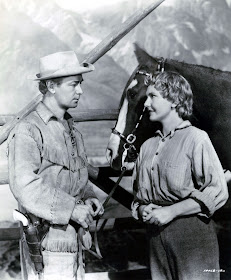The Shane Showdown --- Part One
Looks like a Shane dust-up brewing. This is what lightning-pace Internetting can do to announced Blu-Rays ... put them in controversy's column when there's hint of a foul-up, which we've apparently got here thanks to Paramount intent for a 1.66 ratio in accord with Shane's premiere at
For the record, I absolutely think Shane should be released in 1.37, or at the least, as viewing option on a two-ratio disc that would quell controversy by letting us choose which version of the show to watch. What's happening is reprise of 1953 panic for expanded screens. Now that televisions are being sold with wide view, programming is being pulled like taffy to fit them. Ever watch TNT or other networks where images are freakishly stretched to avoid dreaded black bars on left and right of your screen? There's perception today that we want every inch of TV real estate filled with image. Wide sets may lead to altogether finish for broadcast of old movies, leaving us with survivor discs and whatever gets streamed. Should full-frame Shane issued earlier on standard DVD now go in safety deposit boxes?
George Stevens filmed Shane long before an industry went widescreen daffy. Release just six months earlier would have spared everyone a muddle. Trouble was the stretch-screen gold rush in full press just as
 |
| "Joey, There's No Going Back From Distorting a Director's Intended Ratio. Right or Wrong, It's a Brand, and The Brand Sticks" |
 |
| Would These Lowdown Yankee Liars Endorse Shane in 1.66? |
Other trade publications, always eager to play ball with ad-purchasing producers, kept criticism down to a whisper. Variety's "Inside Stuff --- Pictures" column of 4/29/53 made tactful reference to New York's opening: Radio City Music Hall, N.Y., preemed Paramount's Shane on its new, flat 50X30 screen last week (4/23) and came up with what's regarded as a definitely improved pic, particularly in the scenic shots in which the George Stevens production abounds. Screen's 1.66 to 1 aspect ratio occasionally clipped images top and bottom and a certain amount of light loss was noticeable, particularly in low-key scenes, but these are figured minor blemishes. Size of the Hall makes the larger surface so acceptable that it's difficult to imagine a smaller screen ever having been in use there. Should Blu-Ray purchasers now accept a Shane with said "minor blemishes" as referenced by Variety in 1953?
Part Two of Shane is HERE.








It's worth mentioning that many 1.37:1 titles were caught in the eye of the storm during the widescreen revolution in the spring of 1953.
ReplyDeleteHowever, starting with Paramount in mid-March, all new productions were designed and composed for the wider canvas.
More information, and precise dates when each studio switched to widescreen cinematography, can be found on this page of our website:http://www.3dfilmarchive.com/home/top-10-3-d-myths/early-widescreen
Mr. Furmanek makes an excellent point about flat titles on the market in early 1953. Cinemascope on the horizon may explain why Fox released the standard-ratio STARS AND STRIPES FOREVER during the Christmas season of 1952; it would have been old-hat by the summer season of 1953.
ReplyDeleteWhy was SHANE in the can for several years after filming, as you say?
ReplyDeletePaul Duca
George Stevens was very slow and painstaking with post-production on all his productions. It was not unusual for him to spend a year in the editing room with the miles of film he shot.
ReplyDeleteHas anyone else ever noticed that the standard DVD release of Shane available for some years now changed the soundtrack of the film's famous ending?
ReplyDeleteIn the film's original ending, as immortalized on screen, the wounded Shane is seen riding towards the mountains as the young boy (played by Brandon de Wilde) calls after him to come back.
Originally, the boy's last words heard, softly but distinctly for those who listen carefully, were, "Bye Shane." Those two words were, in fact, the last two in the film, occuring with about ten seconds left in the movie.
I always found the young boy's final words to be quite poignant, signalling that at the last moment he realizes that his hero is not returning.
In the DVD release, however, Victor Young's musical score is cranked up so loud at that moment that the words are virtually drowned out.
Whether this was an intentional act or, more likely, a clumsey accident by a sound person not as familiar with the soundtrack as he should have been, I don't know.
I always found it exasperating, however, that the ending of this masterful western was tampered with, particularly since George Stevens Jr. was involved in the DVD release.
I have never, however, heard of either Stevens or anyone else complaining that the film's final two words for years, "Bye Shane" could no longer be heard.
Stevens was editing SHANE between November 1951 and March 1952.
ReplyDeleteIt's a shame those last two words are drowned out in the mix now. Somebody was sloppy when they went back to the separate dialogue, music and effect tracks.
I agree, let's hope that's fixed!
We've updated the page on our site with new information on SHANE, widescreen and stereophonic sound:
ReplyDeletehttps://sites.google.com/site/3dfilmarchive/home/widescreen-documentation